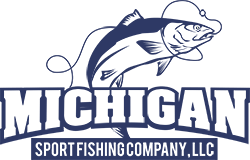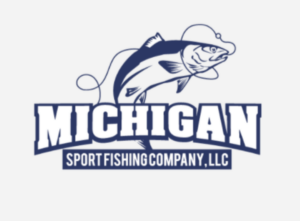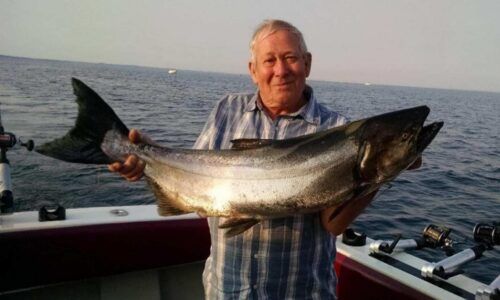
Salmon fishing Michigan started as a solution to an invasive pest
The Alewife
Not native to the Great Lakes, alewife migrated from the Atlantic Ocean into the Great Lakes through the Weiland Canal in the 1920s. Alewife spend most of the year in deep, cold waters. In the spring and summer, they migrate to nearshore areas to spawn and search for food.

The Problem
In the early 1900s, regulators were struggling to establish the exact size of a local fish population. For this reason, they weren’t really able to set meaningful restrictions on the growing commercial fishing industry. The resource was being over-exploited.
This was not the only issue, though. Building sawmills and other facilities caused water pollution and restricted access to spawning grounds in the lakes’ tributaries. A number of local fish species started to decline. And then, the real trouble started.
Similar to Salmon, alewives have a saltwater feeding and a freshwater spawning life cycle. Searching for plankton and smaller fish to feed on, the alewives first made their way to Lake Ontario, then passed through the Weiland Canal to make their first appearance in Lake Erie.
The alewives essentially swapped their Atlantic feeding grounds for the Great Lakes. In Lake Michigan and Lake Huron particularly, they caused devastation on a scale never seen before. But they wouldn’t have been able to cause such wreckage on their own.
In the 1950s, as the alewife population started to swell, another new invasive species appeared. This was the sea lamprey, an eel-like, blood-sucking parasite known for its gruesome rings of teeth. Lampreys feed by swimming up alongside their prey and then clamping down onto the fish with suction-cup mouths.
The alewives had only one natural predator: Lake Trout. As luck would have it, lamprey’s favorite target was this very animal. With Lake Trout out of the way, the alewives were left to ravage the smaller Great Lakes fish unchecked.
Ravaging as they were, the alewives weren’t native to the Great Lakes. They had no mechanism to withstand the Lakes’ wild temperature swings. This led to billions of fish dying off, contaminating urban drinking water, and overwhelming entire beaches with the smell of rotting fish.
The Solution was Salmon Fishing Michigan
As the 1960s rolled on, lake scientists finally had a breakthrough. They devised a lamprey-targeting toxin and introduced it into their river spawning grounds. The poison proved very effective, however, the damage was already done.
The Western approach to fisheries management was completely different from how things were done in the East, though. A huge number of western bodies of water were man-made water basins where scientists created entire ecosystems from scratch. This approach gave Tanner a unique perspective on the Great Lakes situation. Where most could only see a natural disaster, Tanner saw an opportunity. And there was another thing. Up until then, boat fishing on the Great Lakes had been the domain of the commercial fishing industry. Recreational fishers kept mostly to piers and shorelines, going for Whitefish and Perch. Lake Trout might have been the dread of most native fish, but it was pretty feeble when it came to battling anglers, which didn’t make it an attractive game fish.
The two notions gave Tanner a unique idea. He could construct a whole new ecosystem. This one would resurrect the old ecosystem, as well as bring thousands of anglers to the Great Lakes. How did he do it?
Tanner realized that the perfect way to deal with the festering alewives was to introduce a natural predator into their midst. The best part was he could also turn the lakes into a sport fisher’s paradise in the same stride. In his mind, one fish was up to the task more than any other: Pacific Salmon.
The only problem was finding the eggs. Tanner knew how hard this was to do from his days in Colorado. Luckily, biologists had just concocted a new type of dry pellet to feed baby Salmon precisely at that time. Stocking fish was about to change completely, nation-wide. Soon after, Tanner learned that the state of Oregon fisheries department had Coho Salmon eggs to spare. One phone call later, a million Coho eggs were on their way to Michigan.
The experiment worked like a charm. As soon as Coho established a foothold in the lakes, they started feasting on the alewives, and the entire ecosystem started to slowly rebound. Soon after, Tanner and his colleagues started introducing other species of fish like chinook salmon. Thanks to them, the Great Lakes have become a multi-billion dollar recreational fishery.
The Outcome of salmon fishing Michigan
Nowadays, the alewife numbers have dwindled due to a cleaner lake and more predators. With no food source, Salmon stocking had been reduced and is managed at a more predictable level.
What’s actually happening is that the Great Lakes are finally starting to return to their natural state. Lake Trout and Walleye are coming back, This is the ultimate success of Howard Tanner’s plan. But that’s not all.
In 2020, the United States Fish and Wildlife Service estimated the annual net value of the recreational fishing industry on the Great Lakes to be 7 billion, 1.5 to 2 billion in Michigan alone. Come experience this amazing fish story first hand, book a lake Michigan fishing Charter today.
Lake Michigan is a happy and healthy fishery, come see for yourself and try your hand at great lakes sport fishing
A version of this article also appeared in the Launch Issue (May/June) 2021 of Great Lakes Scuttlebutt magazine.
- Fishing
- April 17, 2023






